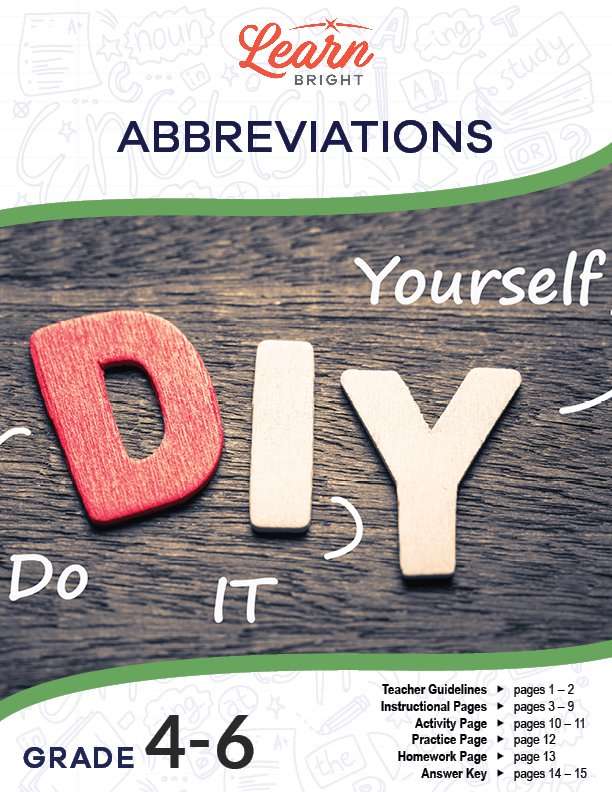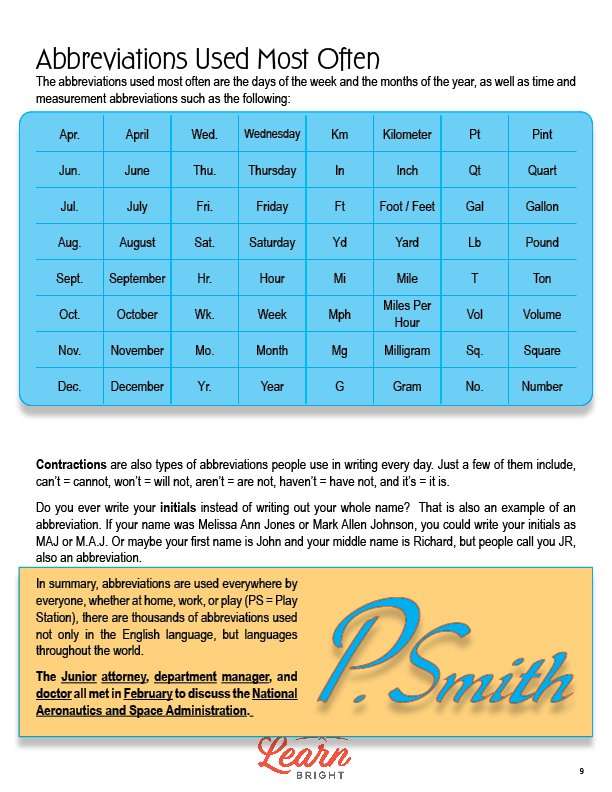Description
What our Abbreviations – Grades 4-6 lesson plan includes
Lesson Objectives and Overview: Abbreviations – Grades 4-6 teaches students the basics about what abbreviations are and how to use them. Students collaborate on an activity to create their own abbreviations. They learn why abbreviations are used and are instructed to identify abbreviations in text and determine what purpose they serve within that text. At the end of the lesson, students will be able to define what an abbreviation is and recognize the most used abbreviations used in writing and for other purposes. This lesson is for students in 4th grade, 5th grade, and 6th grade.
Classroom Procedure
Every lesson plan provides you with a classroom procedure page that outlines a step-by-step guide to follow. You do not have to follow the guide exactly. The guide helps you organize the lesson and details when to hand out worksheets. It also lists information in the green box that you might find useful. You will find the lesson objectives, state standards, and number of class sessions the lesson should take to complete in this area. In addition, it describes the supplies you will need as well as what and how you need to prepare beforehand. The supplies you will need for this lesson are scissors and the handouts.
Options for Lesson
Included with this lesson is an “Options for Lesson” section that lists a number of suggestions for activities to add to the lesson or substitutions for the ones already in the lesson. One suggested addition to this lesson is to allow your students to use the Internet to find more abbreviations to add to the lists provided in the lesson. During the lesson activity, you could allow students to switch partners halfway through. Finally, you can also teach your students about acronyms during this lesson.
Teacher Notes
The teacher notes page includes a paragraph with additional guidelines and things to think about as you begin to plan your lesson. This page also includes lines that you can use to add your own notes as you’re preparing for this lesson.
ABBREVIATIONS – GRADES 4-6 LESSON PLAN CONTENT PAGES
Abbreviations
The Abbreviations – Grades 4-6 lesson plan includes seven content pages, several of which are lists of abbreviations. The lesson opens with a sentence made almost entirely of abbreviations: The Jr. atty., dept. mgr., and dr. all met in Feb. to discuss NASA. Can you read this sentence? It contains six abbreviations and one acronym. Abbreviations are shorter spellings of words or expressions people use every day. Acronyms are substitutes for the words that make up an organization’s name or slogan, often made up of initials. We use abbreviations and acronyms all the time! They’re both shortened versions of words, but they’re not the same.
You might have used abbreviations in emails or text messages to friends and family. We have a whole category for text abbreviations, some of which you might already use. The lesson includes some examples, including AD (awesome dude), AFAIK (as far as I know), and AFK (away from keyboard).
We use abbreviations to save time, use less space, and make writing easier and more efficient to read. The lesson lists many examples of common abbreviations, including Apt. (apartment), Assoc. (association), and Ave. (avenue), among many others.
When to Use Abbreviations
You shouldn’t use abbreviations every time you write. First, you should think about the person who will be reading your writing. In important documents, you should use less abbreviations to make your writing more formal. Some abbreviations end with a period while others do not. Each of the 50 states have an abbreviation, and those abbreviations don’t end with a period. Measurement and time abbreviations don’t either. Sometimes, however, it’s up to you whether or not you want to include a period or not.
Some abbreviations also don’t use the same words or letters as the word, like lb, which is an abbreviation for pound. Oz, short for ounce, is another example of this.
The lesson then lists all 50 states and their abbreviations. We capitalize each of these abbreviations, just like RN (registered nurse) and MD (medical doctor).
The list of US States and their abbreviations includes the state name, its standard abbreviation, its postal abbreviation, and its capital city.
Abbreviations Used Most Often
Some very common abbreviations are the days of the week, months of the year, time, and measurement abbreviations. The lesson lists the most common of these in a helpful chart.
Another type of abbreviation are contractions. We also use these every day. Some of these include can’t (cannot), won’t (will not), and aren’t (are not). Sometimes, you might write your initials instead of writing out your whole name. This is another kind of abbreviation.
We use abbreviations everywhere, at home, work, and play. The English language has thousands of abbreviations, as do other languages around the world!
ABBREVIATIONS – GRADES 4-6 LESSON PLAN WORKSHEETS
The Abbreviations – Grades 4-6 lesson plan includes three worksheets: an activity worksheet, a practice worksheet, and a homework assignment. You can refer to the guide on the classroom procedure page to determine when to hand out each worksheet.
CREATING ABBREVIATIONS ACTIVITY WORKSHEET
Students will work with a partner to complete the activity worksheet. Each pair will cut out the letters on the first page of the worksheet and create abbreviations with them. They will write down their abbreviations and their meanings on the second page of the worksheet.
Students may also work alone to complete the activity.
ABBREVIATIONS PRACTICE WORKSHEET
For the practice worksheet, students will write the word or words for each of the abbreviations listed on the worksheet.
DECODING HOMEWORK ASSIGNMENT
The homework assignment asks students to decode a message from Harriet the Spy in which she uses many abbreviations and acronyms. Students will rewrite the decoded message.
Worksheet Answer Keys
This lesson plan includes answer keys for the practice worksheet and the homework assignment. If you choose to administer the lesson pages to your students via PDF, you will need to save a new file that omits these pages. Otherwise, you can simply print out the applicable pages and keep these as reference for yourself when grading assignments.











